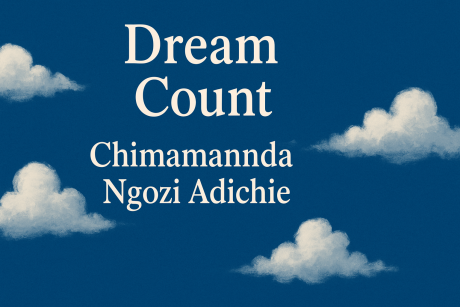Chimamanda Ngozi Adichie's Dream Count Review
BOOKS REVIEW
Chaifry
7/11/20257 min read


Chimamanda Ngozi Adichie’s Dream Count (2025), published by 4th Estate (HarperCollins), is a poignant and powerful novel longlisted for the 2025 Women’s Prize for Fiction. Marking Adichie’s return to fiction after Americanah (2013), this work interweaves the lives of four Nigerian women—Chiamaka, Zikora, Omelogor, and Kadiatou—set against the isolating backdrop of the COVID-19 pandemic. Celebrated for its “luminous prose and emotional depth”, Dream Count explores love, loss, identity, and resilience, earning praise as a “tender yet incisive feminist narrative”.
Adichie, a Nigerian literary giant known for Half of a Yellow Sun (2006) and We Should All Be Feminists (2014), infuses the novel with personal grief, dedicating it to her late mother. For readers, the novel resonates with feminist voices like Margaret Atwood’s piercing social critiques, Kamala Das’s raw emotional honesty, Ismat Chughtai’s subversive wit, and Bama Faustina’s powerful Dalit narratives. This review argues that Dream Count is a must-read for its heartfelt storytelling, nuanced exploration of marginalized identities, and universal themes of human connection, offering readers a shared lens to navigate gender, race, and societal inequities in their diverse contexts.
Dream Count follows four women with Nigerian roots, connected by family, friendship, and work, as they confront personal and societal challenges in Nigeria and the United States during the early COVID-19 pandemic. The novel opens with Chiamaka (Chia), a Nigerian travel writer in Maryland, reflecting on her longing for connection: “I have always longed to be known, truly known, by another human being” (Adichie, 2025, p. 3). Her relationships, from the pretentious Darnell—“It’s a structural erase, a symbolic genocide, because if you’re not seen, then you don’t exist” (Adichie, 2025, p. 47)—to the steady but uninspiring Chuka, reveal her struggle with romantic disillusionment: “Do we need another name… for this state of queasy dysphoria?” (Adichie, 2025, p. 52). The pandemic’s stillness amplifies her introspection: “Where have all the years gone, and have I made the most of life?” (Adichie, 2025, p. 15).
Zikora, Chia’s best friend and a Washington, D.C. lawyer, navigates betrayal and single motherhood after her boyfriend abandons her during pregnancy: “There is no elixir more potent than the genuine encouragement of a lovely person” (Adichie, 2025, p. 89). Her story, expanding Adichie’s 2020 short story Zikora, explores her strained maternal relationship: “The thieves of time, that’s what I called them” (Adichie, 2025, p. 92). Omelogor, Chia’s bold cousin in Nigeria, runs a “Robyn Hood” scheme to fund women’s ventures: “How slippery moralities are, how they circle and thin and change with circumstance” (Adichie, 2025, p. 167). Her move to the U.S. for a master’s in pornography studies and her blog, For Men Only, offer sharp commentary: “Dear men, I understand that you don’t like abortion but the best way to reduce abortion is to watch where your male bodily fluids go” (Adichie, 2025, p. 173).
Kadiatou, Chia’s Guinean housekeeper, endures a traumatic assault inspired by Nafissatou Diallo’s 2011 experience: “His semen in her mouth felt like lingering slithering slimy worms” (Adichie, 2025, p. 215). Her resilience as a single mother shines through: “Kadiatou thought she should have known something was wrong” (Adichie, 2025, p. 220). The novel’s title, a play on “body count,” reflects the women’s tally of romantic and societal disappointments: “Omelogor once said she was happy Nigeria wasn’t a tourist country because ‘people become props, and countries become performances instead of places’” (Adichie, 2025, p. 301). Adichie’s author’s note reveals the novel’s personal core: “This book is really about losing my mother” (Adichie, 2025, p. 387), weaving grief into a tapestry of resilience and sisterhood.
Dream Count is a moving and masterful work, its interlocking narratives showcasing Adichie’s gift for empathetic, vivid storytelling. The prose, praised as “clear as polished windowpanes” (The Guardian, 2025), shines in Chia’s introspections: “I have always longed to be known, truly known, by another human being” (Adichie, 2025, p. 3). This emotional clarity resonates with Margaret Atwood’s The Handmaid’s Tale, appealing to readers seeking introspective narratives, and Kamala Das’s My Story, captivating those drawn to raw emotional honesty. Adichie’s feminist lens, evident in Omelogor’s blog—“Dear men, I understand that you don’t like abortion…” (Adichie, 2025, p. 173)—echoes Ismat Chughtai’s subversive humor in Lihaf, offering a sharp critique of patriarchal norms for audiences valuing bold feminist voices.
Kadiatou’s story—“His semen in her mouth felt like lingering slithering slimy worms” (Adichie, 2025, p. 215)—is a powerful indictment of class and gender exploitation, akin to Bama Faustina’s Karukku, resonating with readers confronting systemic inequities. Adichie’s intent to “write a wrong” (Adichie, 2025, p. 388) restores dignity to marginalized figures, aligning with Atwood’s social justice themes. The pandemic setting—“Where have all the years gone, and have I made the most of life?” (Adichie, 2025, p. 15)—captures universal isolation, connecting with readers’ experiences of lockdown globally. The novel’s structure, weaving four distinct voices, mirrors the layered storytelling of Chughtai’s The Crooked Line, engaging readers with its emotional depth and social commentary.
The novel’s fragmented structure can feel disjointed: “It consists of four stories about four different women that vary in quality and tone, yet are never convincingly connected” (Goodreads, 2025). Zikora’s section, repurposed from a prior short story—“The thieves of time, that’s what I called them” (Adichie, 2025, p. 92)—may feel repetitive to avid Adichie readers. Omelogor’s abrupt career shift—“Why was I doing this, forgetting I had choices?” (Adichie, 2025, p. 180)—lacks depth, potentially frustrating readers seeking nuanced character arcs. The male-centric focus, as in Chia’s reflections on Darnell—“It’s a structural erase, a symbolic genocide…” (Adichie, 2025, p. 47)—has drawn criticism: “It felt very male centered” (Goodreads, 2025), which may clash with Adichie’s feminist ethos, distancing readers expecting Atwood’s female-driven narratives or Chughtai’s bold feminism.
Kadiatou’s third-person narrative—“Kadiatou thought she should have known something was wrong” (Adichie, 2025, p. 220)—creates emotional distance compared to the first-person intimacy of Chia’s and Omelogor’s sections, as noted: “This creates a distance that doesn’t quite work” (Hindustan Times, 2025). For readers, the Nigerian and U.S. settings may feel less immediate than local narratives, and the provocative themes may challenge conservative sensibilities in some communities. Readers accustomed to the cohesive plots of authors like Alice Munro may find the novel’s fragmented structure less satisfying.
Why Indian Readers Must Read This Book
Dream Count is a must-read for Indian readers, particularly those from marginalized communities, because its fierce feminist critique, nuanced portrayal of identity, and unflinching examination of societal inequities resonate deeply with India’s literary traditions of resistance, as exemplified by Kamala Das, Ismat Chughtai, and Bama Faustina. Its exploration of womanhood, grief, and agency offers a powerful lens for Indian readers to confront gender, caste, and disability-based exclusion, inspiring reflection and action in a society grappling with systemic inequalities.
Chia’s yearning for connection—“I have always longed to be known, truly known, by another human being” (Adichie, 2025, p. 3)—echoes Kamala Das’s raw confessions in My Story, where women defy patriarchal constraints to assert their desires. For Indian women in urban centers like Delhi or rural areas like Bihar, Chia’s romantic disillusionment—“Do we need another name… for this state of queasy dysphoria?” (Adichie, 2025, p. 52)—resonates with the societal pressure to prioritize marriage over personal aspirations, encouraging readers to challenge norms around arranged marriages or workplace gender bias. Adichie’s critique of Western stereotypes—“We are all defining our worlds with words from America” (Adichie, 2025, p. 245)—parallels India’s struggle against colonial and global perceptions, as seen in Chughtai’s The Crooked Line, urging readers in Mumbai’s literary circles to reclaim their narratives.
Kadiatou’s story, inspired by Nafissatou Diallo’s assault—“His semen in her mouth felt like lingering slithering slimy worms” (Adichie, 2025, p. 215)—is a searing critique of class and gender exploitation, resonating with Bama Faustina’s Karukku and its portrayal of Dalit women’s struggles. For Dalit or Adivasi women in Maharashtra or Jharkhand, Kadiatou’s resilience—“Kadiatou thought she should have known something was wrong” (Adichie, 2025, p. 220)—mirrors their fight against caste-based erasure, inspiring advocacy for inclusion in India’s public spaces, from inaccessible transport in Bengaluru to limited opportunities in rural Odisha. Adichie’s intent to “write a wrong” (Adichie, 2025, p. 388) aligns with India’s #MeToo movement, empowering women in Chennai or Kolkata to confront workplace harassment or societal stigma post-Section 377’s repeal in 2018.
Omelogor’s subversive feminism—“Dear men, I understand that you don’t like abortion…” (Adichie, 2025, p. 173)—echoes Chughtai’s wit in Lihaf, challenging patriarchal taboos with sharp humor. Her “Robyn Hood” scheme—“How slippery moralities are…” (Adichie, 2025, p. 167)—reflects a pragmatic resistance akin to Bama’s narratives of Dalit agency, inspiring Indian women in self-help groups in Gujarat or urban feminist collectives in Hyderabad to question moral absolutes and pursue economic empowerment. Zikora’s journey as a single mother—“There is no elixir more potent than the genuine encouragement of a lovely person” (Adichie, 2025, p. 89)—connects with Kamala Das’s exploration of maternal bonds, offering solace to Indian mothers navigating societal judgment in urban slums or rural Rajasthan.
The novel’s pandemic setting—“Where have all the years gone, and have I made the most of life?” (Adichie, 2025, p. 15)—captures universal isolation, connecting with Indian readers’ experiences of lockdown in cities like Bhopal or rural areas like Uttar Pradesh. Its exploration of grief—“This book is really about losing my mother” (Adichie, 2025, p. 387)—resonates with Indian readers processing familial loss, particularly in communities valuing intergenerational bonds, offering a cathartic lens for reflection. The portrayal of sisterhood—“Omelogor once said she was happy Nigeria wasn’t a tourist country…” (Adichie, 2025, p. 301)—mirrors the solidarity of Indian women’s movements, from Dalit activism in Tamil Nadu to queer advocacy in Delhi.
The novel’s accessibility, despite its 399-page length, makes it a compelling read for students in Bhopal or professionals in Bengaluru, while its global perspective broadens the worldview of Indian readers, as noted for On a Woman’s Madness (The New York Times, 2023). Its resonance with the feminist critiques of Kamala Das, Ismat Chughtai, and Bama Faustina makes it a vital text for Indian readers seeking narratives of resistance, urging them to challenge societal barriers and embrace their full potential in the spirit of Navratri celebrations of resilience or Kabir’s teachings of inner truth.
Dream Count by Chimamanda Ngozi Adichie is a luminous, if imperfect, return to fiction, earning its place on the 2025 Women’s Prize longlist. Its evocative prose, as in “I have always longed to be known, truly known, by another human being” (Adichie, 2025, p. 3), and sharp social critique, like “How slippery moralities are…” (Adichie, 2025, p. 167), showcase Adichie’s mastery. Despite a fragmented structure and occasional male-centric focus, its resonance with Margaret Atwood, Kamala Das, Ismat Chughtai, and Bama Faustina makes it essential for readers. Its exploration of love, loss, and identity inspires reflection on societal challenges, from gender inequity to caste exclusion. Highly recommended, Dream Count is a transformative call to confront inequities and celebrate resilient storytelling.
